Die Misandristinnen: Über Susanne Sachsse, Viva Ruiz und Kembra Pfahler
DVD / VoD
Der kanadische Filmemacher Bruce LaBruce und die US-amerikanische Künstlerin Vaginal Davis kennen sich seit über 30 Jahren. Die beiden Queercore-Ikonen, die heute teilweise (LaBruce) bzw. ganz (Davis) in Berlin leben, haben in zahlreichen Projekten künstlerisch zusammengearbeitet: in Filmen wie „Super 8 1/2“ (1995) und „Hustler White“ (1996), Theaterstücken wie „CHEAP Blacky“ (2007) und „The Bad Breast“ (2009) oder als DJs in legendären Clubnächten im Berliner Schwuz. Davis, deren unnachahmliche Performance-Kunst von dem Kulturwissenschaftler José Esteban Muñoz einst überaus treffend als „Terrorist Drag“ bezeichnet wurde, hat bei LaBruces neuem Film, der queer-feministischen Terrorismus-Satire „Die Misandristinnen“, zwar nicht selbst mitgewirkt. Aber ihre Freundschaften mit den drei großen Underground-Stars des Films, Susanne Sachsse, Viva Ruiz und Kembra Pfahler, gehen wie ihre Beziehung zum Regisseur „way back“. Ihr Triple-Porträt über LaBruces Queer Legacy Actresses ist nicht nur mit schärfstem Gossip gewürzt, sondern ist auch eine kühle Spitze gegen das noch immer zutiefst misogyne System Hollywoods.
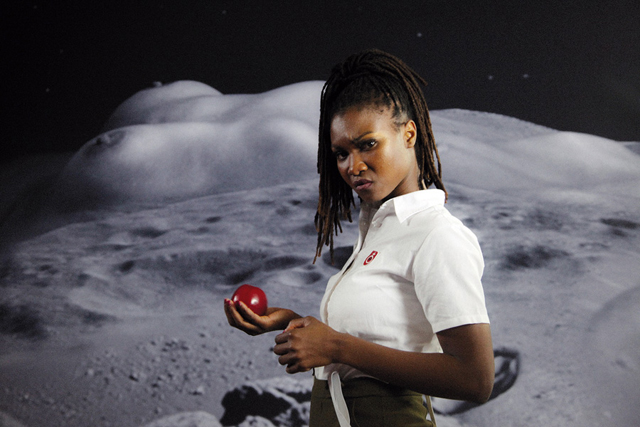
Foto: Edition Salzgeber
The Womany of „The Misandrists“
„Women helped build the film industry, but they are treated as inferior.“
Manohla Dargis, The New York Times, Oct. 11, 2017
I’ve known Canadian auteur Bruce ‚Judy‘ LaBruce for longer then I care to admit in public. Our relationship first began through letter writing or snail mail in the mid 1980s when I was editing my scandalous literary tabloid „Fertile La Toyah Jackson Magazine“ in Los Angeles and he and G.B. (Gloria Berlin) Jones were creating their own underground publication in Toronto, mischievously called „JD’s“.
In those days we would write long declarations of love and admiration to each other that were also part therapeutic in nature as we admitted all of our sins, fears, and transgressions as well. I first started writing to G.B. Jones, then „Judy“ got wind of it, and of course was jealous, and then he and I formed a fervent correspondence.
These letters also included drawings, paintings, photos, and ephemera and would sometimes be lengthy, taking on an almost chapbook quality or in some cases seemed more like handwritten mini novelas. It wasn’t out of the ordinary during those heady salad days to write between 25 and 100 pages a letter.
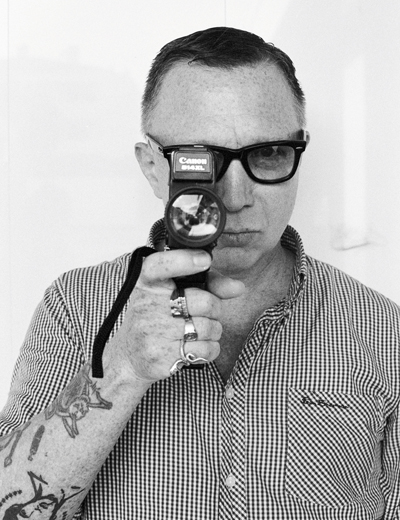
Bruce LaBruce – Foto: Raul Hidalgo
One of the main factors that has made Bruce LaBruce’s better films so unique is the women in them. G.B. Jones disassociative sparkle in „No Skin Off My Ass“ (1991), Stacy Friedrich and Chris Teen Martin as Googie and the Friday Sisters Jane & Wednesday (Friedrich in the dual role as Jane & Googie) in „Super 8½“ (1994), Nickki Uberti as Cameltoe in „Skin Gang/Skin Flick“ (1999), and Susanne Sachsse in „The Raspberry Reich“ (2004), „Pierrot Lunaire“ (2014), and „Ulrike’s Brain“ (2017).
With the release of La Bruce’s latest film „The Misandrists“ in Ger(wo)many, I thought it would be a hoot to profile three of the films spectacular stars: Susanne Sachsse, Viva Ruiz, and Kembra Pfahler.
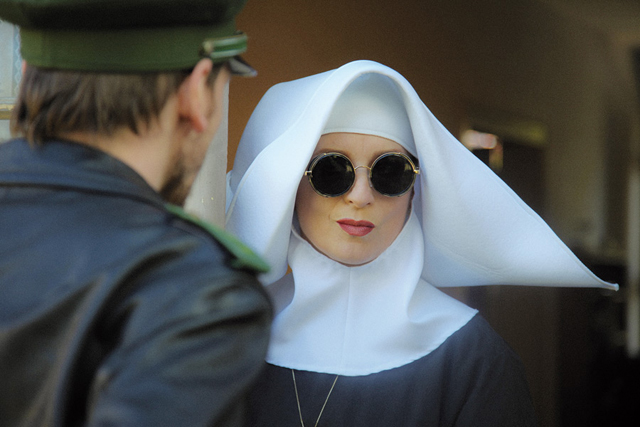
Susanne Sachsse als Big Mother – Foto: Edition Salzgeber
Like a lot of La Bruce’s movies „The Misandrists“ is a quasi remake. This time out the send up is of Don Siegel’s 1971 Southern gothic drama „The Beguiled“, which was officially remade this year by Sofia Coppola. „The Misandrists“ stars Susanne Sachsse as Big Mother. In the 1971 film Geraldine Page played a similar character known as the Headmistress. Ms. Page and Ms. Sachsse are two of my all-time favorite screen personalities. While Page and Sachße are two different kinds of actresses, they share one similarity: When you see them on that big house of the silver screen salver you are immediately riveted.
As a classically trained actress and former member of the famed Berliner Ensemble La Sachsse comes with a weighty pedigree. Sachsse was born in the small GDR town of Jena near Leipzig. Besides a slamdunk performance in „The Raspberry Reich“, which is the prequel to „The Misandrists“, she has distinguished herself on stage working with such greats as the late Einar Schleef, who became a major influence on her, along with poet, novelist, and playwright Heiner Müller. She also worked with American avant-garde impresario Robert Wilson during his very creative famed Berlin cocaine period.
I first met Susanne when she and Volker Spengler were performing in Los Angeles in 1999 in Bertolt Brecht’s „The Resistible Rise of Arturo Ui“. Like many others I was mesmerized by her ethereal beauty and slightly bratty punk charm. She immediately reminded me of a younger version of my long-time comrade in arms Alice Bag of the seminal punk band The Bags. The year 1999 in Los Angeles was momentous in that Susanne also met and fell madly in love with Marc Siegel. Siegel was a hairy and humpy young, Jewish intellectual and junior film historian. The chemistry between Sachsse and Siegel was so powerful and pervasive that it changed her life and the course of herwostory forever. Not just romantically but professionally, as two years later Sachße would emerge as the fearless leader of Kollektiv CHEAP, formed in 2001 along with Siegel and Daniel Hendrickson the Ameri-Scandinavian, Jewish/Muzlim musician and translator to the academic shtars of Europa.
CHEAP’s first big performance piece was „CHEAP Jewelry“ based on the underground films and performance work of the celebrated downtown New York artist Jack Smith, and the music of Hollywood film singing star Carmen Miranda. After „CHEAP Jewelry“ Sachsse vowed never to return to mainstream theater again. Now she works primarily as an intermedia artist/curator/actor/director, not limiting herself in any fashion.
Her latest project is the concert installation „Original Sin“. In „Original Sin“ Sachsse not only collaborates with Xiu Xiu but with her partner of almost 20 years Marc Siegel, artist and curator Jonathan Berger, the producer of CHEAP’s „The Magic Flute: An Opera in Six Steps“ from 2015, the brilliantine stage designer Şenol Şentürk, make-up/hair designer/fashion stylist Akira Knightley and „Re-Phil“ Collins and his students, who will create special videos as part of a mentorship program. The event will premiere December 8-11 at silent green Kulturquartier in Berlin-Wedding. Sachsse has written the lyrics to all the songs in the concert. Here is a little taste of the content as aptly described by Susanne Sachsse:
„It is a true story, it is my story, the story of my conflicted admiration and disdain for my grandmother, Luise Brand. While the East German government was building up its so-called anti-fascist protective wall around Berlin, Luise Brand conceived and built a majestic private house in a small village in Thüringen, where she lived with her older husband, her younger lover, her two dogs, and her two daughters. Her house walls were twice as thick as the Berlin wall. The Berlin wall is gone. Luise Brand is dead. GDR socialism has failed. The house has succumbed to an evil destiny. Capitalism. It is reborn bad. It’s alive and it’s not pretty!“
***
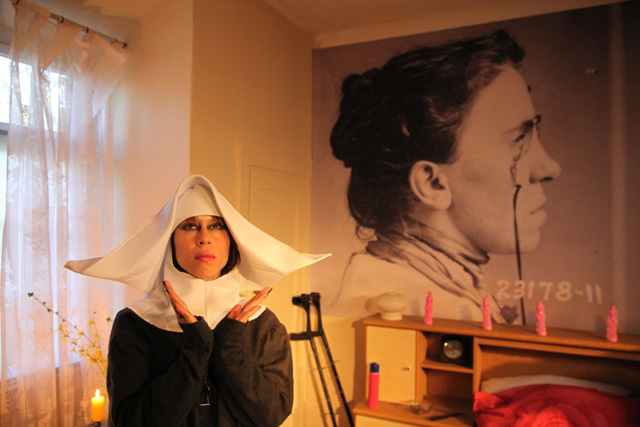
Viva Ruiz als Sister Dagmar – Foto: Edition Salzgeber
„Money often serves as a rationale for some of the industry’s noxiousness, including its sexism and racism. We can’t hire women, blacks, etc., because they don’t sell. Outsiders tend to see the industry as liberal, and while insiders do promote progressive causes, the business hews to a fundamental conservatism. This conservatism shapes its story recycling, its exploitation of women (and men), and its preservation of a male dominated, racially homogenous system. Despite pressure, including from the likes of Ava DuVernay and Lena Dunham, the industry resists change. Those in power don’t see an upside in ceding it.“
Manohla Dargis, The New York Times, Oct. 11, 2017
When I think of the great and glorious Viva Ruiz, the earth angel Sister Dagmar in „The Misandrists“, the 1977 song „Native New Yorker“ by Odyssey plops down in my head:
Runnin’ pretty, New York City girl
(twenty-five, thirty-five).
Hello, Baby, New York City girl.
You grew up ridin’ the subways,
running with people.
Up in Harlem down on Broadway,
you’re no tramp, but you’re no lady,
talkin’ that street talk.
You’re the heart and soul of New York City.
When reviewing just a random selection of the varied projects and practices Viva has been a part of for the last 25 years it can be stymieing. I first met her when she was in the stripper/industrial rock group Thrust with sister in the cloth Kelly Webb. She became a stripper as a distinctly political act and went into sex work with priestesshood intentions. Stripping was the official start of her performance career.
She reminded me, „I met you at a drive-in theater in LA when we screened the Thrust movie and I did a performance where I pulled a tampon out of Kelly Webb’s pussy with my teeth! That’s when you and I became friends!“
She was also a member of the legendary downtown club Jackie 60’s House of Domination, which was like a nightlife Cooper Union Art School with Viva as star pupil and campus cut-up.
I don’t remember the time frame involved but next I think came Vampyros Lesbos, the sexadelic dance party and Euro pop speakeasy that she ran with two Germans from the Black Forest. Back to music it was Fresh Fish, the minimal disco band, with frequent collaborator Kelly Webb plus Jaiko Suzuki and Raj Roy, who is now the chief film curator at MoMa. I was forever bumping into Viva as she traveled the world in the glittery naked street dance cult Dazzle Dancers. Escandalo was an electro dance music sidebar with former clubkid turned humpy baby daddy Desi ‚Monster‘ Santiago. She also joined forces with the Caribbean queer collective Ragga NYC led by Neon Christina Ladosha of the World Famous House of Ladosha: „It’s a mutual seeing and acknowledgement that I think is necessary, keeps us strong. We need posse to combat all this violence coming at us.“
Viva has also worked with Deitch Projects, Big Art Group, The Crystal Ark, and Citizen’s Band.
Viva Ruiz is a bold queer feminista warrior goddess, but also a wise sage, a committed social activist, an interpretive dancer, director, musician, artiste, and provacateuse extraordinaire. In appearance she hasn’t changed at all from when I first met her in the early 1990s. She still gives off the sweet elixir of a sensual teenage joyrider all hopped up in a muscle car cruising the Eastside Highway, hormones raging with exhilarating abandon.
And we have to talk about her exalted sense of all things fashion forward. Where a lot of New Yorkers stumble and come across as downright dreary in their perfunctory all black uniform, leave it to Miss Viva to reinvent and totally make over the color white, giving it a brand new aura. Only Lady Viva can take the decrepit palette of a vestal virgin and sanctify it to the level of a high holy right reverend sacred temple prostituta.
Reuniting with her at the opening of the exhibition „Trigger: Gender as a Tool and a Weapon“ at the New Museum in New York was exhilarating. I was curious as to how she sees herself these days.
„I am a dancer, musicmaker, filmmaker, advocate, artist, and big mouth. What’s on my mind lately? Fascism, racism, misogyny, transmisogyny. Ending all these things. Doing my best to de-center cis het normativity and whiteness. Excited that definitions of every way of being are imploding. I am here for it. Horrified at how much all these bigotries can live in myself and in the most self-described progressive radical circles. It’s just like the horror movie ‚The Thing‘. It’s all coming to light right now in a way that’s big. God has sent me here to be a truffle pig rooting them out, starting with myself and then radiating. I am ready to be entirely new and divorced from programmings and propaganda, somehow. Working towards that new way of being.“
I love how all you need to do is say one word and it unleashes a fervent flow of compelling thoughts from Viva’s lovely mouth:
„I’m obsessed and in conversation with spirits constantly. Identifying as a citysexual having primary relationships with entire cities. It’s been long-term marriage with New York City. With the cities in Ecuador it’s love but more platonic, and since around 2008 I’ve had an extremely heisse on-off affair with Berlin.“
„I’ve been detached from identifying numerically for most of my time on earth, just like Sun Ra, Eartha Kitt, and Prince, meaning when people ask how old I am, I say, ‚I self identify‘. I may even be from Saturn, I don’t know yet. I’ve always been old and young, and that changes and stays the same at the same time. It’s true I’ve been a mother to many but always also a reaper. Status quo seems to want to relegate me to that nurturer role, especially as time passes. There is a folder with a number on it that people really want to file you in. I am enjoying this detachment-from-biology moment the world is having, detached from answering to people and institutions who insist on knowing universally accepted concrete biological facts around gender, sexual preference, and time. It’s fascinating to abstain from reporting to those identifiers and watching the squirming that follows.“
Since I’ve had such a long history with Viva it’s only natural that those we both knew and loved who are no longer here would come up in conversation. One of those treasures was Lower East Side trans noble Chloe Dzubilo of the punk outfit Transistors. I will never forget hosting the wonderful Miss Chloe at my spacious compound in Los Angeles Koreatown Kiez in the 1990s and having her perform at my Sunday afternoon performance space and beer bust Club Sucker at the Garage…
„Concurrently I’m excited to offer my sweetness and my sword to people who are newer in this dimension“, Viva illuminates, „because people like the grand Chloe Dzubilo taught me how. Chloe was a self-described ‚love warrior‘ trans woman and relentless activist who spoke of gender euphoria, she held me close while she hacked away at the world. My birth mother did the same thing as a non-English-speaking factory worker immigrant in New York, so I don’t see parenting separate from being ready to kill things too, I guess they seem to go hand in hand. Now lifetimes later Chloes’s care and lessons are still bearing all this new fruit. People who walk ahead of us have all this information … I knew but I didn’t know at the time. In that same relative way I’m here for anyone who wants the info I’m carrying. Chloe and I have a growing relationship, even though she’s a ghost now, I’m accepting more deeply how tangible the power of ancestors are, and how accessible. They are here and they are teaching and talking and also some are armed. We have allies in all dimensions. I’ve had so many lifetimes already and love stories, more than I think most get to have, it’s wild and feels like it’s just beginning. You are never told that being alone can be luscious and romantic and I’m having that now. We are all off the grid if we want to be from how things used to have to be. I don’t think I had a childhood when I was supposed to so now it’s just lying over the rest of the arc of this life, I mean all I want to do is dance, play, and make friends, it’s a good offset to how much rage I feel 1000% of the time so the work comes out of those combinations – and I am always working.“
When asked how she is dealing with her righteous rage she said: „There are lots I’m doing at the moment, these end of days full of rage days. Rage recently funneling into reproductive justice work, I made these designs around abortion, something to combat how much more anti-abortion/fascist propaganda there exists out here, I wanted to make my own joyful pro-abortion propaganda. The project is called #THANKGODFORABORTION, which started as a design concept, then put on a t-shirt, now I have a theme song for it, a performance that goes with it, and I’m cutting a movie and I’m going to make a music video around it. In a nutshell, with my anti-stigma pro-abortion crusade with 20% of t-shirts always going to an organization that directly helps people access abortions like Fund Texas Choice or Planned Parenthood. Until abortion is accessible to all, safe, and free I am working on being the Shakira of pro-abortion Latin dance tracks and performance. I love and really see how all the new waves of children keep tearing shit up in NYC, it’s never not been that way. Anywhere I can fan their flames I do, cuz its truly hard out here.“
Asking Viva about her mentors and what she has been involved in lately brought this response: „Many including Mariana Ruiz, Annie Sprinkle, Otter, Kembra Pfahler, Chloe Dzubilo, Grandmother Margaret Behan aka Red Spider Woman of the Cheyenne nation. Of course I’ve been a fan of Bruce LaBruce for a long while. Bruce and I have been friends since we bonded at the Copenhagen Film Festival, back when he was screening ‚Hustler White‘ and I was there screening a Thrust porn karate short I co-wrote and co-starred in. I remember distinctly bonding over a wild karaoke night in Copenhagen screaming „let me pee, let me pee“ over the Beatles’ ‚Let It Be‘, much to the dismay of the real earnest singers there. ‚The Misandrists‘ was a real godsend to work on as far as being back in the process and the love of being in production again, making work with family I already had and finding new family too. I remembered just how fun it is to act and that I like to do it. It brought me back to Germany at a perfect time and re-inflated and inspired me working with so many women, all of whom I fell in love with and stay in touch with. Kembra and I were roommates through it all, which was a scandal, and someone should have made that reality TV show, too late now. It was a powerful assortment of femmes caring about each other deeply. After we made ‚The Misandrists‘, I was jumpstarted to make a film of my own featuring a crossover of Misandrists Lina Bembe, Caprice Crawford, and Manuela Schinina, I’m grateful to Bruce for re-lighting the fire. This latest film is a bilingual melodrama I think of as an episode from a telenovela series in my mind. A meditation on the theme of monogamy, called ‚MONOTONY‘.“
***
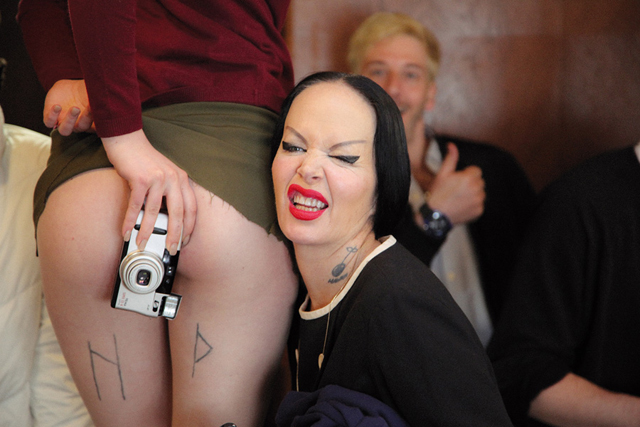
Kembra Pfahler als Sister Kembra – Foto: Edition Salzgeber
„Harvey Weinstein is not an aberration.
He is an ordinary, malignant symptom of systemic sexism.“
Manohla Dargis, The New York Times, Oct. 11, 2017
Kembra Pfahler, who plays Sister Kembra in „The Misandrists“, was born and raised on the beaches of Southern California to surfing pioneers Judy Ball and Freddy Pfahler. She began her career as a child actress, but in 1979 moved to New York City to go to art school and became part of the Cinema of Transgression underground film movement. She later formed her art and music collective The Voluptuous Horror of Karen Black to underscore her film work. In the last 25 years TVHoKB has become a worldwide phenomena that propels Pfahler’s theory of Availabism: making use of what is easily and readily available and Anti-Naturalism. Pfahler is also a living deity and punk rock religious icon worshipped by international followers who know her as she-who-must-be-obeyed.
Kembra Pfahler is one of those people who I’ve known forever who can still thoroughly amaze and surprise me. Recently I saw her on stage at the Broad Museum’s Summer Happening in Los Angeles, and part of her performance turned into an onstage whisper fest between Kembra and her Voluptuous Horror Girls. She had completely tuned out the audience. Now that is stage alchemy of the highest order. For those of you completely uninitiated into the Kembra cosmos I thought it best just to let her speak for herself. So here she is, unedited, using that unique syntax, punctuation, and language that can only be described as surfer patois mixed with New York City Lower East Side moxie:
Hello Miss Davis,
I have been primarily focusing on Judy La Bruce although I will say I am distracted by staying up all night and extracting money from horndogging old men. One in particular I never thought life would end up being this political this extreme, but I’m thankful to say it has. I have so little patience for the commercial side of feminism. Why I say this is because just a few years ago before our first Hole Gallery Future Feminist show, no one wanted to speak about or come out of the closet as a feminist.
I feel that because of the lack of available subject matter to pool from people in normal show business realized they could capitalize on feminist projects or female driven work suddenly. It’s popular to seem be pro female. So there is a desperation in the air about including oneself in these movements. The same goes for the new trans popularity. What Future Feminism meant to draw attention to was the conditions we are existing in and how fragile our existence is. This without a homebase to work in, we will have no actual place to be feminist or argue about our gender or sexuality. The tenets of future feminism were written by five of us during long retreats, that wanted to establish a paradigm of communication between people that we felt was becoming extinct. It shocked me when I saw how much money these t-shirt companies were making on this slogan initially started in the 1970s. „The Future is Female.“ We got hate mail because we wrote this slogan as our thirteenth tenet. Everyone hated it, we were called names and I lost most of my New York friends. They felt it wasn’t progressive to say female. For me femaleness and femininity is a life force and a way of examining the world in a different way completely. That is why I don’t say I’d like to be equal with men, I don’t want what men do at all. I don’t support the systems in place that are perpetuated by men. Feminism requires the participation of us all, and we all benefit by this way of thinking, living, behaving. This conversation is a long one. I can’t provide any positive soothing sound bites to articulate my perspective quickly. Although time is of the essence.
When Anohni, Coco Rosie and Johanna Constantine did our show „Future Feminism“ at the Hole in 2014 we were out branded by some terrible garmentos who made „The Future is Female“ t-shirts. They might be Los Angeles garmentos which as you know is the worse kind of garmento as Los Angeles is a city meant for clothesless people. I know what I’m saying as a third generation Los Angeles person. I’m not proud of it you just can’t get your DNA off you.
So Bruce LaBruce’s interest in feminism has existed since I’ve known him in the ‘80s. He’s always asked me questions about from how and where my feminism was born. I would say.. Los Angeles… a city so vile in its misunderstanding of women that it was my only job as a teenager to be homesick for it but to leave it and come to NYC at 17…
After AIDS and after Giuliani cut out the so-called bad parts there was a tidal wave of gentrification that New York was responsible for and as everything happens in New York first so the rest of the world followed. Followed being terrorized, being so civil liberteed.
Back to my point. Bruce has been interested in activism his whole life and because I have remained a hedonist I haven’t noticed the time passing so I didn’t really realize. He’s been at his work nearly 4 decades. he is not a part of this current fashion of being pro women. His work has always had elements that touched upon this subject.
I’m writing this to you on the #1 train. I have recently after not riding the subways since 1979 decided to ride them mostly because the subways now have wifi so you can continue to work, and most people I know live so extremely far away now. I’m on my way to Harlem. It’s night time. I’m inappropriately dressed, meaning its Fall I’m wearing a t-shirt and jeans.
I’m not just getting home from work, nor am I going home to feed my kids. I’m going to pick up rare library books. It’s almost Halloween. I have agreed to so many shows that I am saying will be my last. I’m starting a film and record company to support my popularity. Every few years it seems I get popular for a minute then it goes away. I learned not to pay attention to attention because it’s mood altering, and distracts me from my work. Sometimes being an artist distracts you from being an artist, so you have to be something else in order to do your best work. I am writing you Ms. Davis now trying to remember the initial question.
What do I remember most about working on the set of „The Misandrists“? It was a chance for us all to be together. We stayed in a weird East German Airbnb.
During our break from filming Viva Ruiz went to Berlin to that techno club that’s open all the time. I just walked around the neighborhood and thought about Hitler as I usually do when I’m in Berlin or any part of Europe for that matter. It’s all a big WW2 film set really even the new parks are just overgrown bomb sites like the movie „Blow-Up“. In that film you got a sense of how large the parks were in London, mostly because London was so utterly flattened in WW2.
So I’m not a very modern European visitor, besides when you go to Europe everyone is just emulating Marcy Avenue hip hop people or graffiti. The rest of the world is really dressing like New York, as much as you all hate us, you can’t deny the fact that we don’t look like or make misidentified films like you do in your town.
In Aarhus, Denmark, no on dresses or makes bands in the Aarhus scene. Paris, France, well maybe France has indigenous culture. I don’t know really. I’m sure I’m wrong. My opinion is subjective. I love everything basically, and feel a sense of enchantment visiting all of the spots around the world I’ve gotten to see. Most of those places, as long as I’ve been alive, have been misogynist, females always behind the line, women frowned upon, laughed at, derided.
Hmmm so that’s why feminism exists still because the world as we know it is still misogynistic, and unlike the civil rights fight in the ‘60s, there is not one large group of activators willing to risk their lives for the betterment of females. We are still joked about, frowned upon mitigated, raped, torn down, … the whole 9 yards of extreme behaviors is directed towards us, your mom, your sister, your friend.
When I first met Bruce I felt he always treated me with grace and respect. I’ve had some very positive role models growing up in supermario New York. You as well Ms. Davis, because you never wavered in opinion about the artists you loved and respected. When I first met Bruce he challenged me. We were enemies because of a film I’d made that he didn’t like. Years later, we couldn’t remember what the fight was about.
„The Misandrists“ is a beautifully written piece that is the bread that transports the jelly or important information to all of its viewers. I would watch the film with a pen and blank paper at hand. Write down all of the evidence and references Bruce alludes to in this movie. It’s rich. What else happened? A lot. I’m freestyling really…
I am not a good actor and couldn’t remember any of my lines. I had to make cue cards that I promptly lost. Bruce didn’t get angry, but we carried on. I did the best I could but knew… I fell short as I couldn’t recite lines at all. The other women were very good. All of them. We all became friends, I love Sam and Bliss and just had a show with them in Copenhagen. These younger women will reign completely… they are all hard-working artists. We all looked out for each other, I will say we all bonded a great deal during this film.
Thankfully, from early early on I haven’t cared how the art world has regarded me. If there were more fuckable people in it I’d be there more but there’s not. I have acquaintances that are really bothered by lack of proper art world recognition, but I don’t care, and it seems that the art world likes that about me. I don’t know who I’m referring about… maybe curators or museum people.
You can’t convince someone to disconnect, I just know that my abhorrence for popularity thankfully grew out of being exposed to such a creepy side of the film industry in Los Angeles at such a young age. And going against all that was popular allowed me to create my own vocabulary. I think others get mad if they sense you are disturbed by this stuff.
I should make a horror movie about it. I’ll call it … „On Golden Castle Breakers or Panic in Needle Apartments“.
Mehr von Vaginal Davis gibt es auf ihrem zügellosen Blog zu lesen.

Die Misandristinnen
von Bruce LaBruce
DE 2017, 91 Minuten,
englisch-dänisch-deutsche OF mit deutschen UT,
Edition Salzgeber
Hier auf DVD.
